

21 Technologies That Will Decentralize the World. Across the planet, new technologies and business models are decentralizing power and placing it in the hands of communities and individuals.
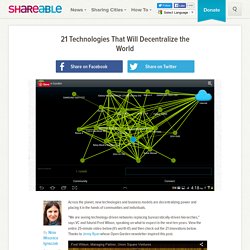
"We are seeing technology-driven networks replacing bureacratically-driven hierarchies," says VC and futurist Fred Wilson, speaking on what to expect in the next ten years. View the entire 25-minute video below (it's worth it!) And then check out the 21 innovations below. Thanks to Jenny Ryan whose Open Garden newsletter inspired this post. Here are 21 innovations that will help make it happen: 1. Decentralized technology will become mainstream in 2014, according to the Open Garden Foundation, a San Francisco-based startup dedicated to net neutrality and internet access for everyone. 2. Building Creative Commons: The Five Pillars of Open Source Finance. This is an article about Open Source Finance.
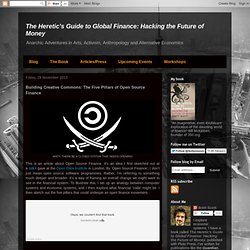
It's an idea I first sketched out at a talk I gave at the Open Data Institute in London. By 'Open Source Finance', I don't just mean open source software programmes. Rather, I'm referring to something much deeper and broader. It's a way of framing an overall change we might want to see in the financial system. To illustrate this, I set up an analogy between computer systems and economic systems, and I then explore what financial 'code' might be. Computer systems as economies Computer systems are great metaphors for economic systems. The Financial Status Quo: Power concentrated in intermediaries Software code is the organising rule system that steers energy into activating hardware towards particular ends.
But it takes more than clearly-worded documentation to be able to create financial instruments. Opening access, reconnecting emotion, liberating creativity Pillar 1: Access to the means of financial production Pillar 2: Widespread distribution. mWater. D-CENT - Decentralized Citizens ENgagement Technologies. About GNUnet. GNUnet is a framework for secure peer-to-peer networking that does not use any centralized or otherwise trusted services.

Our high-level goal is to provide a strong free software foundation for a global network that provides security and in particular respects privacy. GNUnet started with an idea for anonymous censorship-resistant file-sharing, but has grown to incorporate other applications as well as many generic building blocks for secure networking applications. In particular, GNUnet now includes the GNU Name System, a privacy-preserving, decentralized public key infrastructure. The reproducibility of good science. Image by opensource.com I gave a talk at this year's TEDx Albany event, "Saving Science - Open Up or Perish," where I talked about something that I am very passionate about.
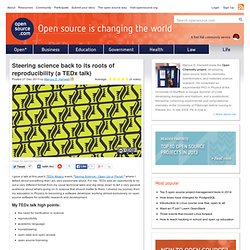
For me, TEDx was an opportunity to try out a very different format from my usual technical talks and dig deep down to tell a very general audience about what's going on in science that should matter to them. I shared my journey from my education in Physics to becoming a software developer working almost exclusively on open source software for scientific research and development. My TEDx talk high points: Linux For Everyone. ” Linux is Everywhere.
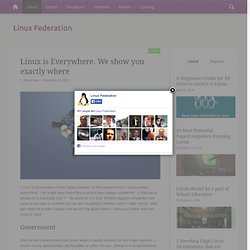
From Space Stations to Microwave Ovens, Linux powers everything.” You might have heard that a lot and have always wondered ” Is that just a phrase or is it actually true ? “ Be assured, it is true. World’s biggest companies use Linux in one way or another but you are not going to believe unless I take names. Well, get ready for a roller coaster ride across the globe where I show you where and how Linux is used Government Most of the Governments use Linux, which is pretty obvious for two major reasons. America – Starting July 2001, The White House started migrating the computers to the Linux-based Red Hat Linux and Apache HTTP Server and the migration was completed in February 2009. The United States Department of Defense uses Linux – “the U.S.
In 2006, the US Federal Aviation Administration announced that it had completed a migration to Red Hat Enterprise Linux in one-third of the scheduled time and saved 15 million dollars. Education Businesses and non Profits. Five characteristics of an open source city. Image by opensource.com Which of these characteristics is most important to start a local open government movement?
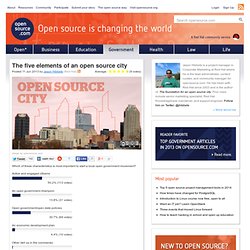
Active and engaged citizens 50.2% (113 votes) An open government champion 13.8% (31 votes) Open government/open data policies 30.7% (69 votes) An economic development plan 4.4% (10 votes) Other (tell us in the comments) 0.9% (2 votes) How can you apply the concepts of open source to a living, breathing city? Hardware is now open (sourced) for business. Adafruit's revenue has tripled year over year, and the company projects full-year revenue for 2013 will reach $20 million.
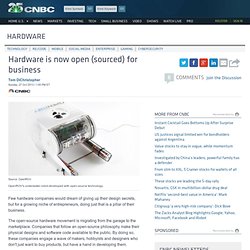
Customers are not just limited to hobbyists and isolated makers, said Limor Fried, founder of Adafruit. "Our customers are moving more and more towards commercial endeavors and a very large portion of our orders are from professionals at very large companies," said Fried. The movement is also gaining steam at maker spaces, public workshops that offer access to production tools and the training to use them. Mark Hatch, CEO of TechShop, says he sees an uptick in the number of people interested in open-source ventures. He credits the advent in recent years of low-cost computer boards like Arduino, BeagleBone and Raspberry Pi, all of which are open-source themselves. One of the companies Hatch is excited about is OpenROV, a small-batch manufacturer of underwater robots developed at TechShop's San Francisco space.